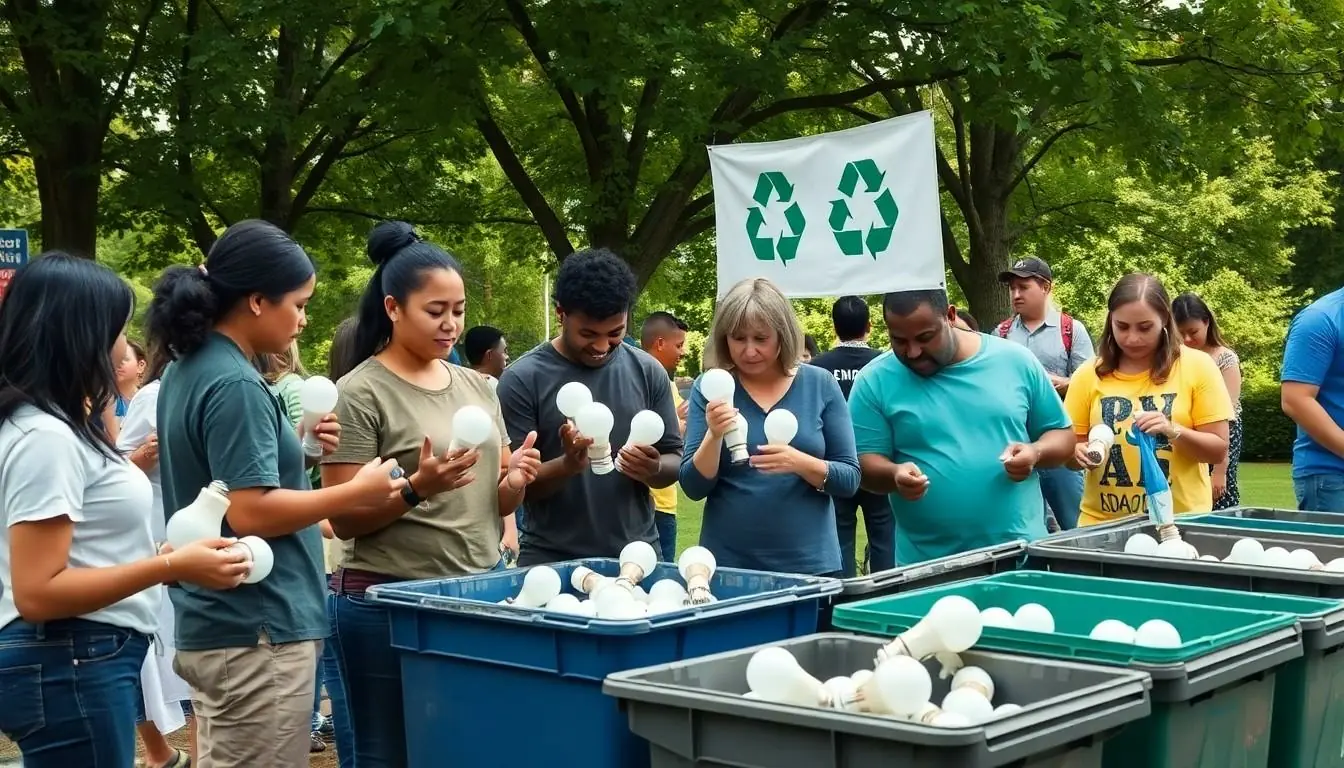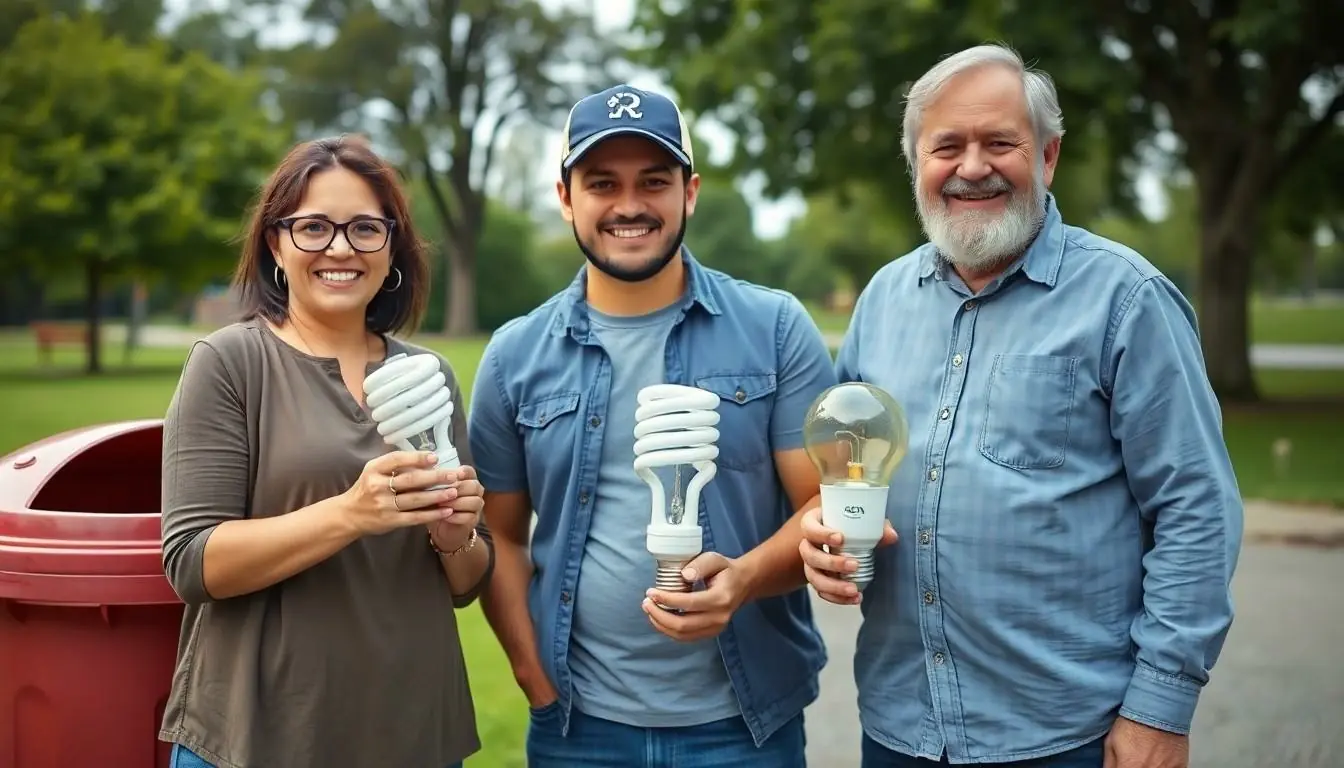Light bulbs may seem harmless, but they pack a punch when it comes to waste. Those shiny little energy-savers might brighten up your home, but what happens when they flicker out? Tossing them in the trash isn’t just a bad idea; it’s like sending your old friends to a party where they’ll never be invited back.
Table of Contents
ToggleUnderstanding Light Bulbs
Light bulbs play a crucial role in daily life, providing illumination for homes, workplaces, and public spaces. Recognizing their types and environmental impact informs better disposal practices.
Types of Light Bulbs
Incandescent bulbs produce light through heating a filament. These bulbs offer warm light but are energy-intensive, with about 90% of energy converting to heat instead of light. Compact fluorescent lamps (CFLs) use around 70% less energy compared to incandescent bulbs, making them a more efficient choice, though they contain a small amount of mercury. Light-emitting diodes (LEDs) have rapidly gained popularity due to their energy efficiency and long lifespan. With up to 80% less energy consumption, LEDs are a sustainable option for modern lighting.
Environmental Impact of Light Bulbs
Light bulb waste contributes substantially to landfill issues. Incandescent bulbs account for around 9 million tons of waste annually in the U.S. CFLs and LEDs, while less wasteful, still pose hazards due to mercury content in CFLs and incorrect disposal methods. Improper disposal can lead to toxic substances leaching into soil and groundwater, creating potential health risks. Recycling light bulbs prevents harmful substances from entering the environment, highlighting the importance of responsible disposal practices and community programs aimed at recycling.
Importance of Recycling Light Bulbs

Recycling light bulbs plays a crucial role in reducing environmental harm. Proper disposal practices protect health and support sustainable waste management efforts.
Benefits of Recycling
Recycling light bulbs conserves resources by reclaiming valuable materials. Many components in bulbs, such as glass, metal, and plastic, can be reused in new products. Economic savings also arise from recycling, as it lowers the cost of raw material extraction. Community recycling programs further enhance local job opportunities and foster environmental awareness. By reducing landfill contributions, recycling light bulbs helps minimize greenhouse gas emissions. Additionally, it encourages responsible habits among consumers, promoting a culture of sustainability that benefits future generations.
Hazards of Improper Disposal
Improper disposal of light bulbs poses significant health risks. Many fluorescent bulbs contain mercury, a toxic element that can leak into the environment. Soil and water contamination may result from broken bulbs in landfills. Health complications linked to mercury exposure include neurological damage and other serious conditions, especially in vulnerable populations like children. Furthermore, broken bulbs can cause physical injuries. Responsible disposal is critical to prevent these hazards and protect community health. Awareness of the risks associated with improper disposal helps motivate individuals and communities to adopt safer recycling practices.
How to Recycle Light Bulbs
Recycling light bulbs requires awareness of local disposal methods. Many communities offer specific recycling programs designed to handle these items responsibly.
Local Recycling Programs
Local recycling programs often operate through municipal waste facilities or dedicated recycling centers. Residents can check their city’s waste management website to find nearby drop-off locations. Many retailers also partner with local initiatives by setting up collection bins in their stores. Individuals may also discover community events focused on proper light bulb disposal. Participating in these initiatives fosters environmental responsibility and creates a support network for sustainable practices.
Mail-In Recycling Options
Mail-in recycling options provide a convenient alternative for those unable to access local programs. Various organizations accept light bulbs through mail-in services, allowing individuals to send bulbs directly to specialized recycling centers. Customers typically receive prepaid shipping labels, simplifying the process. This option ensures safe transport of hazardous materials, such as CFLs that contain mercury, reducing environmental risks. Many consumers find it beneficial, as they can consolidate their bulb recycling efforts and ensure proper disposal without leaving home.
Best Practices for Safe Handling
Proper handling of light bulbs is essential for safety and environmental protection. Implementing the right practices ensures minimal risk during disposal and recycling.
Safety Precautions
Use gloves when handling light bulbs, especially for CFLs. Gloves protect against breakage and reduce exposure to hazardous materials. Avoid direct contact with broken glass; instead, use a broom and dustpan to safely collect shards. Ensure well-ventilated areas when dealing with CFLs, as mercury exposure poses health risks. If a bulb breaks, follow local guidelines for cleanup and disposal. Keep out of reach of children and pets to prevent accidents. Educate family members on safe handling techniques to promote awareness and safety at home.
Packing and Transporting
Package light bulbs securely before transporting. Use original packaging if available; it provides maximum protection during transit. Wrap each bulb in newspaper or bubble wrap to prevent movement and breakage. Seal packages with tape to ensure contents remain intact. Designate a sturdy box or container for transport, and label it clearly to signify fragile contents. Use vehicles with adequate space to avoid overcrowding, reducing the risk of accidents. Transport bulbs directly to recycling locations to minimize handling time and potential damage.
Recycling light bulbs is not just a responsible choice but a necessary step toward environmental stewardship. By taking the time to properly dispose of these everyday items, individuals can significantly reduce waste and mitigate harmful impacts on health and the environment. Communities that embrace recycling initiatives foster a culture of sustainability that benefits everyone.
With various options available for recycling light bulbs, from local drop-off centers to mail-in programs, it’s easier than ever to participate. By adopting safe handling practices and staying informed about local regulations, individuals can contribute to a healthier planet. Every small action counts, and together, they can lead to meaningful change.





